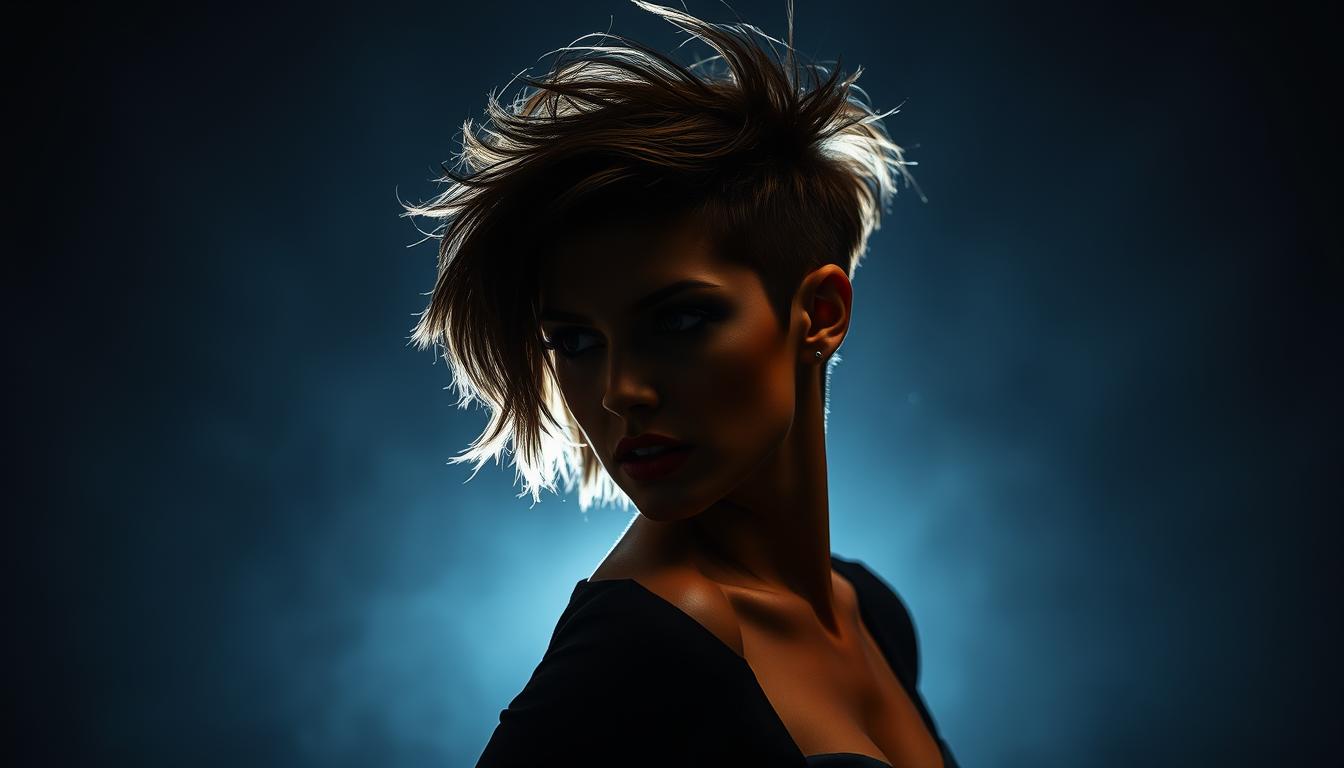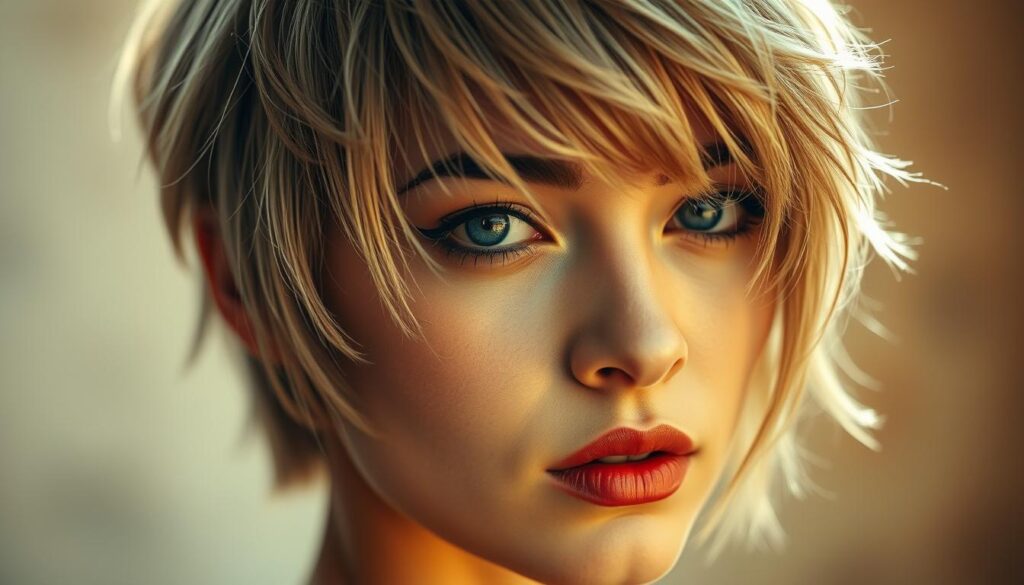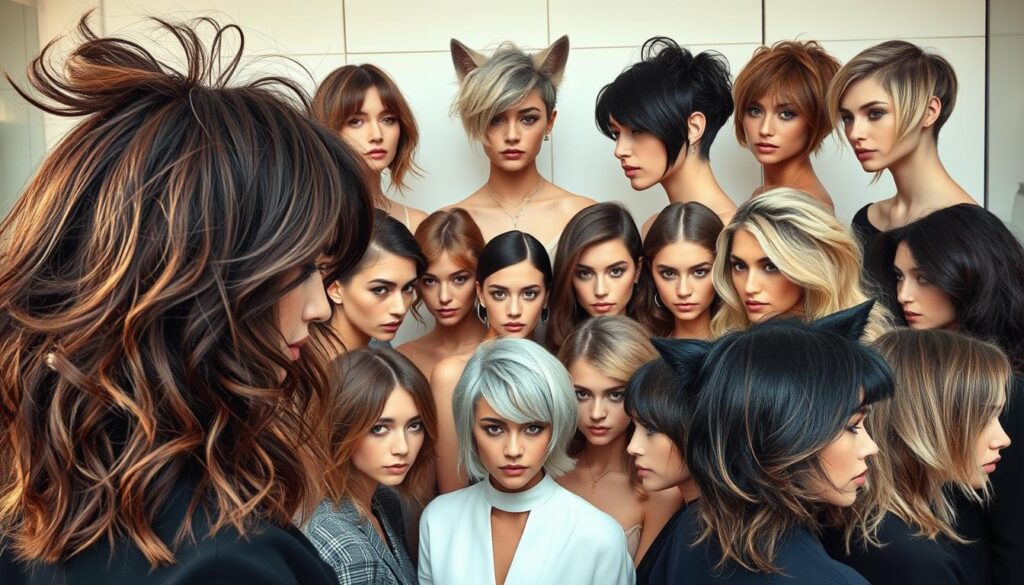
What if your hair could mirror your wildest self—untamed yet polished, bold yet adaptable? The wolf cut answers this question with a roar, blending rebellion and refinement into one showstopping style. This hybrid of shaggy layers and mullet-inspired texture has stormed TikTok feeds and red carpets alike, proving it’s more than just a fleeting trend.
Celebrities and influencers adore its ability to frame every face shape while amplifying natural texture. Unlike rigid styles that demand daily upkeep, this look thrives on imperfection. Think bedhead meets runway-ready—a balance of chaos and control that works for straight, wavy, or curly hair.
Why does it resonate so deeply? It’s versatile enough for boardrooms and concerts, offering a personalized edge. Whether you crave subtle volume or dramatic layers, the wolf cut molds to your personality. Social media buzz reveals its power: users report newfound confidence after embracing its dynamic shape.
Key Takeaways
- Combines shag and mullet elements for a modern, textured appearance
- Works with all hair types and face shapes for inclusive styling
- Requires minimal styling to maintain its effortlessly chic vibe
- Gained viral popularity through social media transformations
- Balances edgy aesthetics with wearable sophistication
Introduction to the Fierce Wolf Cut Trend
The fashion scene is howling with excitement over a hairstyle that defies convention. Born from the rebellious spirit of 70s shags and 80s mullets, the wolf cut reimagines retro vibes with a modern twist. Its jagged layers and lived-in texture create a “just rolled out of bed chic” aesthetic that’s dominating Instagram feeds and salon requests alike.

What makes this style stand out? It’s all about strategic chaos. Stylists craft uneven layers that boost volume at the crown while softening facial features with face-framing pieces. The result? A look that’s equal parts wild and wearable—perfect for those craving edge without daily styling marathons.
Social media turbocharged the trend’s rise, with TikTok tutorials racking millions of views. Users love how it works with natural waves or straight strands, requiring just a quick tousle with texturizing spray. As one influencer put it: “It’s like my hair finally matches my personality—a little messy, totally confident.”
From red carpets to coffee runs, the wolf cut adapts effortlessly. Celebrities have proven its versatility, pairing it with sleek suits and concert tees alike. More than a passing fad, it’s become a symbol of self-expression for those rewriting beauty rules—one choppy layer at a time.
What is a Wolf Cut? Unpacking the Style
A hairstyle born from punk roots now dominates as a symbol of fierce individuality. This edgy look fuses the mullet‘s rebellious energy with the shag‘s carefree layers, creating something entirely fresh. Its secret? Balancing wild texture with wearable shape.
Definition and Origins
Born in underground music scenes, this wolf cut gained traction as artists rejected polished beauty standards. The 1970s brought choppy experimentation, while 80s rockers amplified its asymmetrical edge. Today’s version keeps that spirit but adds modern precision.
Key Elements and Texture
Three features define the look:
- Graduated layers that stack volume at the crown
- Face-framing pieces varying from cheekbone to jaw length
- Deliberate texture through razoring or point-cutting techniques
Stylists often remove bulk from mid-lengths while leaving ends full. This creates movement that dances with every head turn. The result? Hair that looks wind-swept, not overworked—perfect for low-maintenance glam.
The Evolution from Mullet to Modern Shag
Hair history took a sharp turn when rebellious roots met modern finesse. The wolf cut didn’t emerge from nowhere—it’s the lovechild of two iconic hairstyles. Picture the 80s mullet’s daring contrast meeting the 90s shag haircuts’ effortless layers.
![]()
Original mullet styles screamed rebellion with cropped fronts and wild backs. By the 2000s, stylists softened those harsh lines. They borrowed feathering techniques from shag haircuts to create smoother transitions between lengths.
Today’s wolf cut blends the best of both worlds. Choppy layers add movement where old-school cuts felt flat. Face-framing pieces offer the shag haircut’s flattering shape without extreme differences.
This evolution mirrors our craving for versatility. People want hairstyles that adapt to busy lives. The wolf cut delivers—it’s low-maintenance yet bold, professional yet playful. Perfect for today’s world where first impressions matter, but salon time doesn’t.
Defining Features: Layers, Curtain Bangs, and Choppy Details
At the heart of every great wolf cut lies a masterclass in controlled chaos—a symphony of layers, fringe, and texture that dances between wild and refined. This style’s magic comes from three signature elements working in harmony: cascading layers that create motion, face-framing curtain bangs, and artfully jagged details that defy uniformity.

Signature Layers and Movement
The layers in this cut aren’t just random chops—they’re precision-engineered. Starting shorter at the crown and lengthening downward, they create a waterfall effect that lifts roots while letting ends swing freely. Stylists often use point-cutting to craft choppy layers that remove bulk without sacrificing volume, giving hair that coveted “lived-in” bounce.
Emphasis on Curtain Bangs and Framing
Center-parted curtain bangs act like a spotlight for your best features. These wispy face-framers blend into side layers, softening jawlines or highlighting cheekbones. For those avoiding full fringe, stylists might suggest tendrils cut at cheekbone or jaw level—a modern twist that keeps the focus on your bone structure.
What truly sets this style apart? Its movement. Unlike stiff, uniform cuts, the wolf cut’s disconnected layers let each section sway independently. Combined with strategic texture through razoring or thinning shears, it creates dimension that looks artfully undone—never overstyled.
wolf haircut women: Versatile Styles for Every Hair Type
No two heads of hair are alike—and that’s exactly why this trend thrives. The wolf cut bends to your natural texture and length, creating customized shapes that enhance what you’ve got. From shoulder-skimming bobs to waist-length waves, it’s all about working with your hair’s unique personality.

Medium-length styles hit the sweet spot for many. They balance bold layers with easy upkeep—perfect for busy schedules. Textured ends add bounce without looking overdone, while face-framing pieces soften angles naturally.
Long locks get new life with strategic cutting. Removing weight from the mid-sections lets hair swing freely, turning lifeless strands into a moving masterpiece. Curly types love how layers define their coils instead of flattening them.
Short hair? No problem. Stylists craft edgy versions using choppy layers that create the illusion of fullness. Even pixie-length cuts gain dimension when styled with matte paste for that “rolled-out-of-bed” charm.
Fine or thick, straight or coiled—this style adapts. Thick hair sheds bulk through graduated layers, while fine strands gain volume with feather-light texturizing. The secret? Letting your natural texture guide the scissors for a look that’s authentically you.
Celebrity Inspirations and Iconic Wolf Cut Moments
Hollywood’s brightest stars have unleashed their inner edge with this daring hairstyle, turning heads from red carpets to Instagram feeds. Billie Eilish flipped the script with neon-streaked layers that screamed rebellion—her mix of jet-black roots and vibrant tips became a blueprint for fans craving bold self-expression.
Miley Cyrus proved the wolf cut adapts like a chameleon. She swapped platinum shaggy waves for dark, textured ends, showing how one style can morph from rocker-chic to sleek sophistication. “It’s about owning your energy,” she told Vogue, tousling her piece-y bangs.
Jenna Ortega brought youthful flair to the trend, pairing soft curtain bangs with choppy ends that framed her features perfectly. Her version sparked TikTok trends where teens use sea-salt sprays to mimic that “just-surfed” look.
These icons did more than sport a trendy cut—they reshaped beauty standards. Salons report 40% more requests for layered styles after celebrity sightings. Social media amplifies the magic: fans share DIY tutorials using budget tools, proving great style doesn’t need A-list budgets.
What makes these moments stick? They showcase versatility while celebrating individuality. Whether you’re channeling Billie’s punk vibes or Jenna’s California cool, the wolf cut becomes your signature—a badge of confidence that turns every bad hair day into a statement.
Styling for Different Hair Types
Your hair’s natural texture becomes your greatest asset with this trend. Whether you’re working with pin-straight strands or bouncy coils, the key lies in enhancing what you’ve got. Customized techniques bring out the best in every lock type, creating movement that feels effortless.
Straight and Wavy Hair Styling Tips
For sleek or slightly textured hair, start with a volumizing mousse at damp roots. Blow-dry using a round brush to lift sections at the crown. Finish with a texturizing spray scrunched into mid-lengths for that coveted piece-y look.
Those with fine hair can try choppy layers paired with light-hold products. Avoid weighing down strands—opt for feathery layers that create the illusion of density without bulk.
Maximizing Volume on Curly Locks
Curly hair thrives when layers remove excess weight. Apply a curl-defining cream to soaking-wet hair, then diffuse upside-down. For extra oomph, rake a nickel-sized amount of hydrating mousse through mid-lengths before drying.
Thick textures benefit from strategic thinning at the crown. Use a wide-tooth comb to distribute products evenly, preserving natural hair patterns. Pro tip: Oribe’s Dry Texturizing Spray adds grit without crunch for second-day refreshment.
